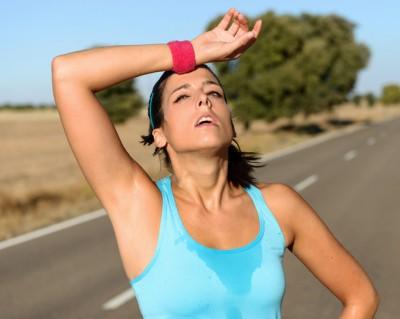We hear people say it all the time, especially at the gym or where runners congregate, as if it's a proven work-out mantra: Hydrate, hydrate, hydrate. The advice in all its forms flows like water itself:
"Make sure you drink lots and lots of water to keep your system refreshed, so you can run cool."
"Gotta drink 8 glasses of water a day."
Or this gem, paraphrasing the esteemed and world-famous internist, Thomas Brady, MD, quarterback of the New England Patriots: Drink enough water that equals half of your body weight, measured in ounces, every day.
Oh goodness.
While Dr. Goldenboy QB's recommendation can actually be potentially dangerous, unfortunately none of the above is true. The primary reason is because there's no specific volume of fluids to consume, since everyone is different and each person's workout intensity varies. Therefore, when it comes to deciding how much is enough while exercising, certified athletic trainers and knowledgable health professionals say the guideline is simple:
Drink enough to quench your thirst – and that's all.
If you down too much during your run or workout, you can unwittingly create a harmful health condition known as exercise-associated hyponatremia, or an overly-diluted sodium level.
 "Don't overdo it. Thirst and the color of your urine are usually the best indications of how much water you need," states the Mayo Clinic. "If you're not thirsty and your urine is pale yellow, you are likely getting enough water." And hyponatremia can be as dangerous as hypohydration, or an acute deficit of body water. (Adjacent symptoms chart, credit: NATA)
"Don't overdo it. Thirst and the color of your urine are usually the best indications of how much water you need," states the Mayo Clinic. "If you're not thirsty and your urine is pale yellow, you are likely getting enough water." And hyponatremia can be as dangerous as hypohydration, or an acute deficit of body water. (Adjacent symptoms chart, credit: NATA)
Meanwhile, the National Athletic Trainers' Association also advises caution to avoid hyponatremia, which in rare cases can be fatal.
"Excessive fluid consumption can lead to life-threatening exercise-associated hyponatremia (EAH), in which extracellular body water enters the cells and causes organ and tissue swelling," reads NATA's 2017 position statement. "The condition can be fatal when brain cells swell and brain tissue herniates through the foramen magnum or the brain swelling triggers noncardiogenic pulmonary edema that leads to respiratory failure."
In fact, there are instances – one involving an otherwise healthy 17-year-old athlete, and another with a 28-year-old woman, for example – where excessive hydration led to fatalities. So, employing a football analogy, Brady's fluid-intake formula is as effective and on-target as one of his passes hitting the hot-dog vendor in the head.
Any "metrics suggest drinking 1 ounce for every pound or kilogram of body weight are largely inaccurate," states Mike McKenney, a certified athletic trainer at Northeastern University, "and depending on activity level, could potentially be harmful."
For healthy adults, sodium, which helps maintain normal blood pressure, should remain at a level between 135 and 145 milliequivalents per liter (mEq/L), and when it dips below 135 hyponatremia is present.
Water isn't the only fluid that can be consumed while exercising. Sports drinks, like Gatorade, are fine as well since they "help replace electrolytes lost through perspiration and sugar needed for energy during longer bouts of exercise." But the Mayo Clinic recommends not consuming them unless "you're exercising intensely for more than an hour."
While replenishing fluids until thirst is satisfied is certainly the way to go, McKenney, who also works for the NBA's Atlanta Hawks as a hydration and electrolyte replacement consultant, adds that "humans only replace up to 70% of fluid losses if we drink until the cessation of thirst."
Therefore, he advises that those who have vigorously exercised "should continue to monitor their body weight and continue to drink following activity – but in amounts that do not cause them to gain weight beyond what they have lost, as the risk to develop EAH is still present."




